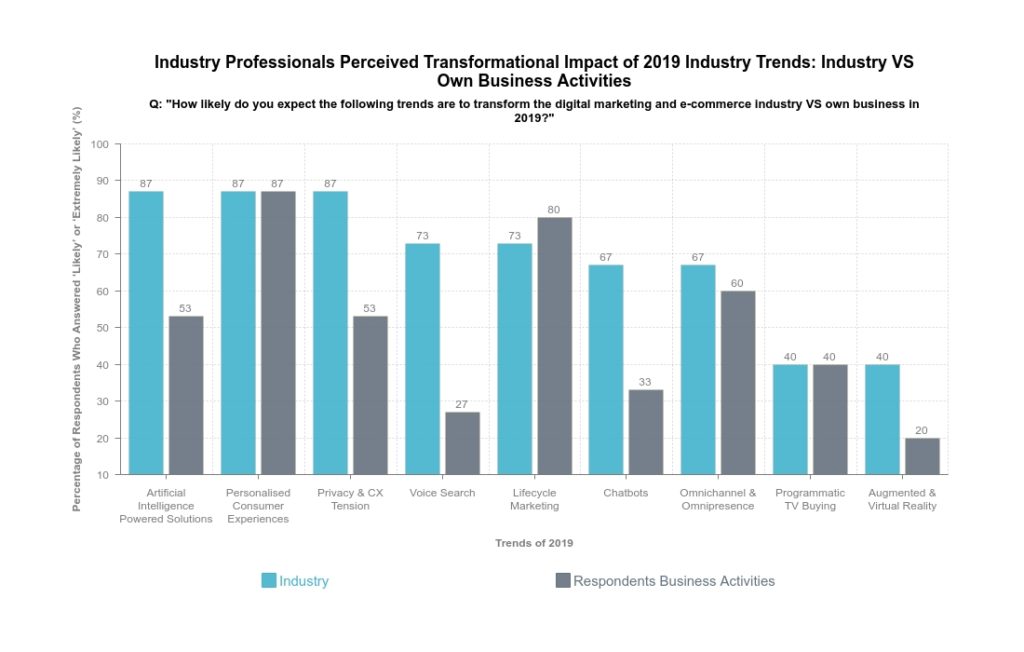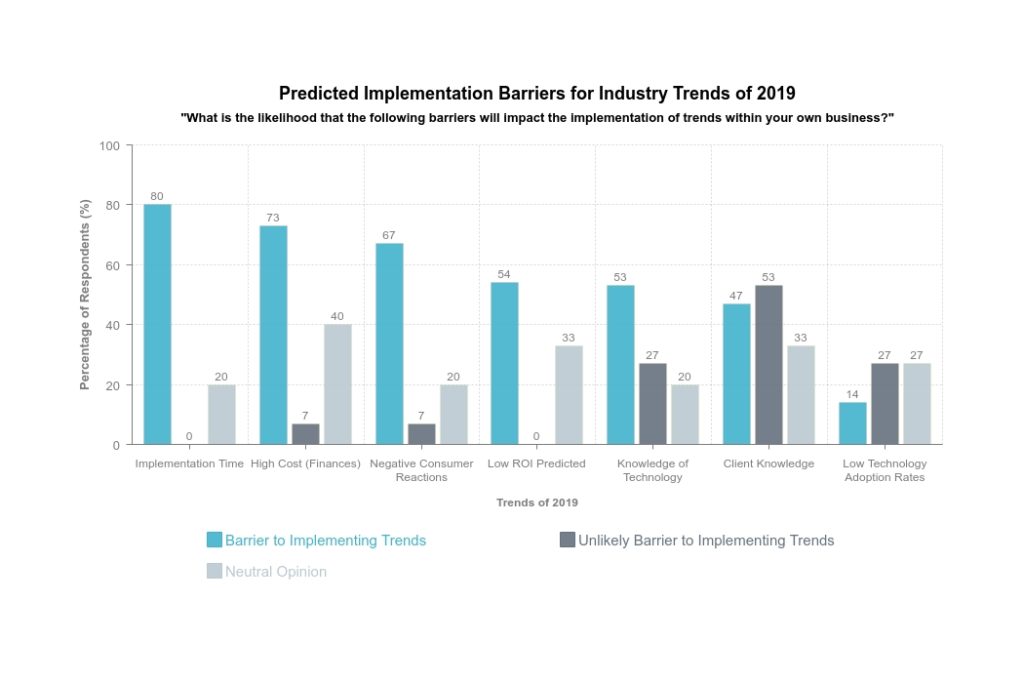Digital Marketing Trends and Predictions 2019
We’re all looking for the emerging industry movements that will deliver real results in 2019.
From AI movements to advanced personalisation, technology is progressing rapidly. All the while marketers are racing to make their initiatives more customer centric.
To help you syphon through the industry buzz words and find the tangible strategies, we’ve asked the leading e-commerce and digital marketing managers about their predictions and goals for the new year.
Read our opinion piece to discover the current digital trends that the industry leaders are paying attention to in 2019.
AI
PROGRAMMATIC TV BUYING
INCREASED COMPETITION
DATA SCIENCE
PRIVACY AND CX TENSION
LIFECYCLE MARKETING
INFLUENCER MARKETING
AI
AI is front of mind for every digital marketer. The question is how fast will it really permeate the industry?
AI will remain task specific this year, but in good time it will disrupt our industry. By empowering machines to think about, respond to, and perform tasks like humans, it is going to have the following benefits:
- Deliver improved customer experiences
- Exceptional ability to analyse and learn from data
- Automations and improved productivity
From automated chatbots that can reach out to your customers and respond to their queries, to making personalised product recommendations based on customer preferences, online habits and previous buying behaviour, AI will become a game changer in the long term.
‘Technology is getting smarter, our ability to identify right person, right time, right screen is getting more accurate and efficient and the ability to scale one-on-one conversations is gaining traction through technology – it goes a full circle!’
– Aimee Gossage
Sales Manager, Quantcast
Mike Cheng from City Beach believes that automation and AI will enable the company to have a greater focus on creativity.
Meanwhile Richard Tarrant from Emarsys can see that,
‘Advances in machine learning are enabling e-commerce companies to close the gap to true 1-to-1 communication at scale.’
We’re also seeing AI make waves in programmatic media buying, which uses real time bidding models, reporting and optimising. We encourage you to maintain a healthy amount of scepticism with vendor claims. Test and prove effectiveness of AI tools yourself.
While the long-term benefits of AI on the industry are clear, our research showed that small to medium businesses aren’t necessarily ready to adopt the technology.

*Results are collated from 15 digital marketing and e-commerce experts.
The majority of our respondents can see that AI will transform the industry, but only 53% of them can see it being applied in their own business this year.
‘We are miles off using deep programming (some call it AI) properly but delivering the right customer experience does require a unique sequence of events and messages for each customer, which is only possible with an automated and flexible martech solution.’
– Luc Meritan
Marketing Lead, Medibank
– Helena Gabanski-Sykes
Principal Consultant, it works
Programmatic TV Buying
Another benefit of ‘deep programming’ will be the expansion of Programmatic TV Buying this year.
A research report produced by IAB found that 82% of Australian consumers watch digital video each month and the video market is experiencing 58% year-on-year growth. Adobe’s State of Digital Advertising Summit 2018 has also shown that ‘the line between digital and TV continues to blur‘.
Programmatic TV Buying combines all the benefits of traditional TV advertising with the advanced targeting and detailed reporting that you get from digital media buying.
Using automated purchasing, advertising is displayed based off audience preferences, rather than more loosely targeting a show or time slot.
High value audience segments are created and targeted using buying behaviours, demographic information and psychographic profiles from 1st, 2nd and 3rd party data sets.
And there are multiple advantages:
-
- Reach audiences when they are most engaged
- Boost video completed views
- Take personalisation to the big screen
- Enjoy more transparency & data
- Target niche audiences
- Run middle of the funnel campaigns
‘Automation will become stronger, more & more media will be bought programmatically, and we’ll all see different ads on whatever screen we are looking at or stream we are listening to. The level of predictable advertising will get bigger, but we will still need humans to tell those machines what to do.’
Aimee Gossage
Sales Manager, Quantcast
Increased Competition
Amazon will have a giant impact on Australian retail. They will be aggressively growing their customer base in Australia with deep discounting, great fulfillment, and shipping supremacy.
No longer will marketers be able to just compete on price. Amazon will always be cheaper and faster. Businesses need to find new ways to deliver customer value and team up with key vendors who can help you streamline your processes (e.g. Shippit).
Bianca Atkinson from Clique That advocates for using unique content to stay competitive in 2019.
‘Voice search is being spoken about a lot in terms of the newest marketing tactic for 2019, however I think it will take a few years to become more mainstream. People are still favouring visual advertising. It’s becoming more and more important to stay competitive and fresh. Content must be unique and on-brand; ensuring that you stand out against your competition.’
On the other hand, Rakshit Bhandari, the Senior Digital Product Manager from Harvey Norman is taking a niche customer centric approach.
‘Marketing departments are becoming smarter in using limited resources to drum up sales. One example can be that they are using forums, blogs, emails, FB or Insta to excite customers about a previously non-existent special sales day. Companies understand their target audience much better now. Not everyone needs to target the millennial crowd. You can build your niche following with other groups. There is no longer holding onto the old mindset of telling customer what to do. Now the mindset is that ‘This is our customer, she likes to chat using Whatsapp. Let’s make sure that she can reach us over Whatsapp’.’
All the while, Luc Meritan’s sites de-digitalisation as Medibank’s biggest competitor in 2019.
‘The trend I’m expecting will change the landscape is de-digitalisation. People will not start using voice search and all have an Alexa in every room. Quite the opposite. They will actively de-digitalise. Use internet in a more focused way with less websites, do everything on their mobiles and start shutting their phones off more often. They’ll disconnect the wifi. They will not embrace the IOT.
The key trend pushing this counter move is the apparition of data and studies on the negative impact of digital devices on people’s lives when used 24/7. Even electromagnetic smog is being looked into. Early signs but this will be a key ask from customers. Give me less digital services that take less of my time because I want to focus on the real world. Make everything automatic, send me notices but otherwise ciao I’m at the beach with my kids. Behaviours and trends are cyclical.’
Helena Gabanski-Sykes is focusing on logistics and UX to create that seamlessly convenient website experience with cut-through.
‘Click and collect/ship from store will continue to increase, more shipping and payment options will be available, and yet more helpful tools such as fit finder will become commonplace. As a result, retailers will have to re-focus back on to UX as websites start to become ‘messy’ and site speed slows. This will go hand-in-hand with an increase of investment in CRO strategies. Retailers have ‘caught up’ with one another in terms of being able to offer a standardised shopping experience online and basic digital marketing campaigns, many are now at a point where ‘fail fast’ testing is too risky from a sales impact point of view; Google Optimize and Optimizely, amongst others, are becoming easier and cheaper to use. It has created the ‘perfect storm’ for CRO niche agencies and tools to dominate in the eCommerce vendor space.
More retailers will look to drop ship opportunities to grow their online sales, leveraging what they already have in place from an operations point of view. This will be prevalent in retailers of all sizes – for larger retailers the focus will be working with suppliers or third-party brands to implement endless aisle and/or reduce shipping costs alongside increasing speed of delivery to customers. And for smaller retailers it’s about getting additional exposure for their brand; digital marketing funds will be redistributed to fund the additional costs of drop ship fulfilment.’
Customer reviews and local relevance will also help you to gain an advantage in 2019.
‘The future of SEO for 2019 is review management and local relevance. Google continues to change its algorithm to give priority to results that are relevant to a searchers location and also to pages/profiles that reflect positive reviews.
For brick and mortar businesses, this means making sure your physical locations are properly represented on social networks and navigation databases. Your profiles should be complete with attributes. The reviews consumers leave you will be key to your ranking so you want to provide positive in-store experiences that lead to positive online reviews.
For e-commerce businesses, this means making sure that your product pages reflect reviews and capture customer experiences. That rich data is full of keywords which helps boost SEO if properly coded. Visitors will also spend more time on your site reading feedback from previous purchasers. That added value can greatly boost the time people are spending on your website which is another indicator to the search engines to rank you higher.’
Ashley Baxter
Founder of Modern Marketing School

Data Science
Increasingly, good digital marketing is looking more like data science. Google continues to roll out and optimise free dashboarding products (such as Google Data Studio), and Power BI has become a go-to for combining multiple data sources. There is also a range of enterprise solutions on the market, that are similarly allowing real-time customer data to guide marketing strategies and tactics.
Retailers will also start seeing more omnichannel value in the data that comes from their digital channels.
‘As Google Analytics continues to be developed as a tool, more omnichannel retailers will start to use this website data as a source of information to inform offline store decisions. e.g. where to trade and what range or type of product to allocate to different geographical locations, what to promote in the window. In many respects none of this data is new, it’s always been there, but as online sales start to account for more than 10% of total brand sales as a norm, rather than an exception, more retailers will start to look to their digital channel to serve as far more than a communication or sales channel.’
Helena Gabanski-Sykes
Principal Consultant, it works
Privacy & CX Tension
Along with the growth of data science comes an increase in privacy issues.
Marketers always want more. More devices are collecting user data and feeding into our understanding of the ‘customer journey’. The utopia of ‘Right place, time, message’ can’t happen without data collection and utilisation.
However, in the background is increasing concern around privacy. We saw the GDPR pan out this year and similar issues could ensue in Australia.
While taking advantage of data, marketers need to continue to query data collection and use, while ensuring that all data protections are up to scratch (especially if selling into the EU). For Ratna Rashid (Smile Dentist Brisbane) and all other marketers, ‘being clear in our privacy policy’ is now a mandate.
‘I think privacy and anti-trust in organisations is at an all-time high.’
Joelene Riedo
Marketing Manager, Mirvac
‘Following the footsteps of EU, the Australian market has become data sensitive, and this will impact majority of the initiatives. Focus will be on improving customer experience & offerings, both online & offline.’
Rakshit Bhandari
Senior Digital Product Manager, Harvey Norman
Sherryl Caulfield
Director, Action Communications
Lifecycle Marketing
Getting that first purchase is just the beginning. More than ever, there is a growing focus on lifecycle marketing.
Lifecycle platforms like Emarsys make it easy for retailers to master lead-gen, while tracking and increasing the lifetime value of existing customers.
A strong lifecycle marketing strategy can mean that simply getting an email address (a lower commitment than a purchase) means a high likelihood of future revenue.
‘Targeted recommendations & personalised experience will continue to be the key focus for e-commerce players. Chatbots have already been handling top questions in the customer service space but highly unlikely to impact the sales side.’
Rakshit Bhandari
Senior Digital Product Manager, Harvey Norman
‘I think we’ve only just begun personalising our marketing communications with lifecycle marketing. In 2019, I expect more AI and machine learning based tools to enter the digital marketer’s tech stack with the aim of delivering a hyper-personalized experience. Messages such as replenishment reminders and loyalty rewards will all leave static time constraints, to start predicting and sending at the exact moment you’re ready to buy next.’
Josh Reyes
Marketing Manager at Smartrmail
‘2019 will be a big year for personalised marketing that feels more genuine and relevant. We will adapt by adopting a more casual tone, tailoring our messaging to segmented markets and avoid marketing speak.’
Roshni Govindaraj
Founder of Issara and Donut Bouquets
It all comes down to being able to talk to each customer in the way they want, in order to move them from prospects to advocates.
Accordingly, Anthony Idle from Dissh Boutiques cites, ‘conversational commerce and increased personalisation’ as key digital marketing trends in 2019. While Mathew Hodge from Queensland Symphony Orchestra will lean on ‘clever content marketing’.

Influencer Marketing
The shine is coming off this darling child of the social media world.
The government is cracking down on undisclosed partnerships and sponsorship agreements. It all stems from an increased demand for transparency from customers.
A strong campaign now requires a strategic selection of influencers as well as transparency. Tools like Scrunch can help you analyse the data to ensure that your influencers’ and own audiences are married up.
The advantages are two-fold. Enhance your ROI while also maintaining brand authenticity.
Ensure that the diverse set of influencers you work with have a genuine and authentic connection to your brand and focus on real engagement rather than the number of followers.
‘The tension between authenticity and brand activism will come to light as businesses will need to reaffirm their business is to serve customer not fight for the cause du jour. Getting the basics right is and will remain the way to keep customers. Brands need to be humble and focus on product and services.’
Luc Meritan
Marketing Lead, Medibank
‘Having genuine ambassadors helps! Not only do they influence, they genuinely enjoy our brand and are happy to promote for us – however, being straight forward and respecting the consumer helps. Really understanding their needs and putting their needs first before business requirements is a must.’
Stephanie Overton,
Digital Marketing Manager, Volkswagen Group Australia
‘We’re gravitating to micro-influencers – like most brands out there. They have a higher engagement because people perceive them as being more authentic and they have time to be able to interact with their followers more – making the work they do, seem less like a throwaway ad. Additionally, they are more enthusiastic/easier to work with.
We’re also looking at championing our own contacts (staff, photography or models and suppliers) to become our partners and share because the want to, rather than influencers that have to be paid to share their thoughts of post their pictures. It takes a loooootttt longer and is more hard work. But we don’t have the budget to work with big influencers and cannot ensure we would get a good ROI. We’re also trying to put more authenticity into what we do as a brand. To become our own influencer!’
Helena Gabanski-Sykes
Principal Consultant, it works
You can also expect to see an increased focus on quality content to build brand awareness and credibility.
‘We rely on internal expertise and education pieces to add to a customers’ experience rather than relying on an external influencer.’
Joelene Riedo
Marketing Manager, Mirvac
‘We will be altering our marketing mix to include more value-added content and credibility building approaches.’
Anthony Idle
E-commerce Manager, Dissh Boutiques
Barriers to Implementation
We’re sure that your mind is brimming with new digital marketing ideas for 2019. However, to get your initiatives over the line, there are a few hurdles you may need to overcome. Our research showed that resourcing and ROI are crucial concerns for implementation.

*Results are collated from 15 digital marketing and e-commerce experts.
‘Local skilled labour is hard to find. Extremely talented individuals are impossible to find. There isn’t the same talent pool in Melbourne than London.’
– Luc Meritan
Marketing Lead, Medibank
‘Cost and time investments required will impact the technology choices being made. If the expected ROI isn’t high enough, then investments will not come through. Single digit ROIs no longer cut it. Technology investment committees are looking for detailed business cases and are being smart about how the money is spent.’
– Rakshit Bhandari
Senior Digital Product Manager, Harvey Norman
‘The main obstacle for us internally is non-marketing existing stakeholders A) understanding the technology B) understanding how it applies to our business and C) what the ROI looks like.’
Alex Oubridge-Egan
Marketing Analyst, Monash IVF
‘Marketing dollars are finite but the channels available continue to expand.’
Joelene Riedo
Marketing Manager, Mirvac
‘Getting good technology skills at reasonable rates is becoming challenging and I expect the problem to worsen in the next year or so.’
Rakshit Bhandari
Senior Digital Product Manager, Harvey Norman
‘Consolidation and ingestion of client data (structured and unstructured) from various sources will be a continued but larger barrier in 2019. Political barriers will become more important as technology, marketing complexity and communication opportunities outpace the knowledge of decision makers who control budget allocation. Sophisticated clients will need to take their C-level on the journey of opportunity to ensure budget is not only allocated to opportunities they understand.’
Richard Tarrant
Emarsys
So how can you get new resources approved in 2019 and overcome friction? Anthony Idle puts it simply:
‘Focus on strong ‘ROI calculations and business case development of technology stack changes.’
Wanting to talk through some new digital marketing initiatives in 2019? If your mind is full of new ideas, then get in touch.